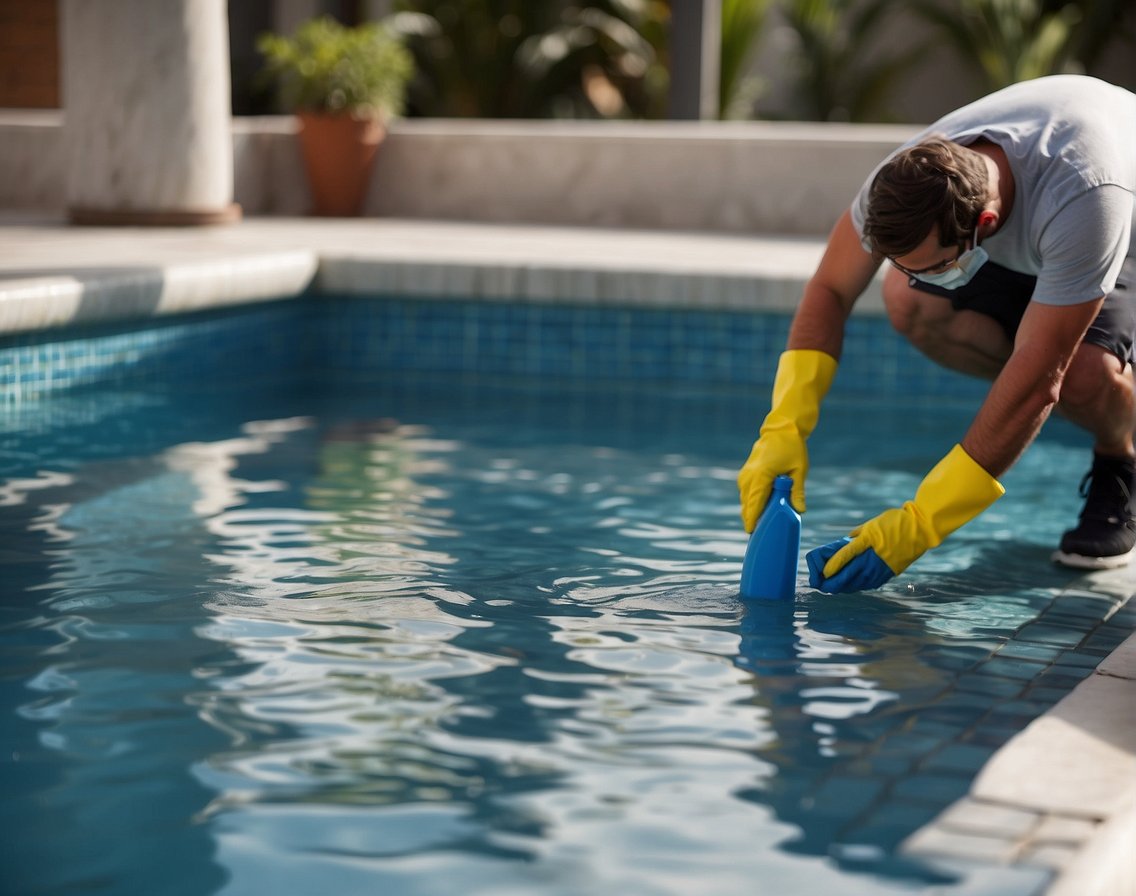Understanding Pool Tile and Grout Maintenance

Maintaining the integrity of pool tile and grout is essential to preserve the appearance of your pool and safeguard against potential health risks.
Identifying Common Pool Tile Problems
In our experience with pool maintenance, we often encounter a few recurrent issues.
- Discoloration: This typically manifests as a faded or altered hue on the tiles, often resulting from chemical imbalances in the water, prolonged exposure to sun, or the presence of contaminants.
- Calcium Deposits: These are white, crusty build-ups that form on tiles, especially in areas with hard water. These deposits can be challenging to remove and may require specialized cleaning agents.
- Staining: Stains can appear on pool tiles due to algae growth, metal objects, or organic material like leaves. The type of stains and the appropriate removal technique will vary based on their cause.
- Grout Degradation: Over time, grout may crack or erode, which compromises the structural integrity and cleanliness of the pool since it can harbor dirt and bacteria.
Factors Affecting Pool Tile and Grout Integrity
Several elements contribute to the long-term health of your pool tile and grout.
- Chemical Balance: It’s crucial to keep the pool’s chemical levels, such as pH and chlorine, within appropriate ranges to prevent damage to tile and grout.
- Cleaning Practices: Regular cleaning is vital. Harsh cleaning practices or neglect can lead to issues like staining and discoloration. Soft brushes and appropriate cleaners are recommended.
- Environmental Exposure: Sun, temperature changes, and nearby landscaping can all impact pool tile and grout. Understanding your environment helps in choosing the right materials and maintenance strategies.
- Water Quality: Hard water can lead to calcium deposits. Using a water softener and consistently checking water quality is beneficial in maintaining tile and grout integrity.
Effective Cleaning Techniques for Pool Tiles

To ensure a clean and hygienic pool, it’s vital to maintain the tiles regularly. We’ll guide you through choosing the appropriate tools, detail a cleaning process, and tackle challenging stains with precision.
Choosing the Right Cleaning Tools
For starters, it’s essential to have the right tools on hand for pool tile cleaning. Our recommendation is to assemble:
- Brushes: A stiff nylon brush for large areas and a smaller toothbrush for corners and crevices.
- Cleaning Solutions: Prepare a bucket with a mixture of vinegar and warm water, or a professional cleaning solution for pools.
- Pressure Washer (optional): Ideal for removing loose grime and algae.
- Pumice Stone: Effective for tackling calcium buildup without damaging the tiles.
Step-by-Step Tile Cleaning Process
The actual tile cleaning process involves a few systematic steps to get your pool tiles looking their best:
- Wet the Tiles: Start by wetting the pool tiles to loosen grime and dirt.
- Apply Cleaning Solution: Using the bucket, mix warm water and vinegar in equal parts. Apply this solution directly to the tiles, allowing it to sit briefly to break down algae and stains.
- Scrubbing: Take your brush and gently scrub the tiles in circular motions, paying extra attention to the waterline where buildup is common.
- Rinsing: After scrubbing, thoroughly rinse the tiles with clean water to remove any residue from the cleaning solution.
- Repeat if Necessary: If the tiles aren’t fully clean, repeat the scrubbing and rinsing process until satisfied.
Special Considerations for Stubborn Stains
Occasionally, you’ll encounter stubborn stains that require a more rigorous approach:
- For Calcium Buildup: Use a pumice stone with gentle pressure to remove the stains without scratching the tiles.
- Persistent Algae Stains: A higher concentration of vinegar in your cleaning solution, or a specialized algae removal product, can be more effective.
- For Tough Stains: Apply muriatic acid diluted with water, but ensure adequate safety precautions such as gloves and eye protection. Always follow manufacturer’s instructions when using muriatic acid.
These methods will clean your pool tiles effectively, leaving them sparkling and free of harmful buildup.
Maintaining Pool Grout for Longevity

To preserve the integrity and appearance of a swimming pool, understanding the characteristics of different types of pool grout and ensuring their correct application and sealing is critical. These steps are essential for the longevity of pool grout.
Types of Pool Grout and Their Characteristics
Grout is vital for the stability and waterproofing of pool tiles. Two main types are commonly employed:
- Epoxy Grout: This grout type is known for its durability and resistance to chemicals and stains. It does not require sealing due to its non-porous nature.
Properties Epoxy Grout Cement Grout Porosity Non-porous Porous Chemical Resistance High Moderate Application Complexity More complex Easier Need for Sealing No Yes - Cement Grout: More traditional and budget-friendly, cement grout does necessitate sealing to protect against moisture and chemicals.
Ensuring the correct grout choice for specific pool conditions is pivotal. Epoxy grout, while more costly and intricate to mix and apply, often presents a superior long-term investment due to its resilient traits. Cement grout, easier to apply, requires thorough sealing and regular maintenance.
Proper Application and Sealing of Grout
- Grout Application: The consistency of the grout mix is essential. A uniform, smooth paste allows effective application with a grout float. The angle and pressure used to spread grout influence its bonding and coverage.
Grout Sealing for cement-based grouts:
- Allow curing of grout for the recommended period, typically 48-72 hours.
- Clean the surface with a grout brush and a pH-neutral grout cleaner to remove any residue.
- Apply grout sealer with an applicator or spray, ensuring even coverage.
Whether it’s epoxy grout or cement grout, removing excess grout before it hardens is vital. This involves scraping off the excess and wiping down tiles with a damp sponge, maintaining a clean tile surface. Regular cleaning and the occasional deep clean using appropriate grout cleaner can effectively extend the life of sealed grout.
Balancing Water Chemistry for Tile Preservation

Maintaining balanced water chemistry is crucial for preventing tile degradation and ensuring longevity. We focus on routine monitoring and immediate response to chemical imbalances to preserve the tiles’ integrity.
Preventing Calcium and Mineral Buildup
Improper water chemistry, especially high calcium hardness levels, can lead to calcium and mineral deposits on pool tiles. These deposits often present as a whitish scale, known as calcium carbonate, or a slightly harder compound named calcium silicate. To prevent this:
- Maintain the calcium hardness level between 200-400 parts per million (ppm).
- Ensure total alkalinity remains within 80-120 ppm to help stabilize pH levels.
Utilize a sequestering agent to keep minerals in solution and prevent their adherence to tiles.
Monitoring and Adjusting Chemical Levels
Regular monitoring of pool water ensures the chemical levels are conducive to preserving tile integrity. Paying attention to the following will help avert any potential tile damage:
- pH Levels: Keep the pH between 7.2 and 7.8 to avoid acidic conditions that can etch tile surfaces.
- Chlorine Levels: Use chlorine tablets wisely to maintain a chlorine level of 1-3 ppm, which is effective for sanitization without causing damage to the grout.
- Algae Growth: Inhibit algae growth by managing phosphate levels and ensuring proper circulation, which can prevent algae from staining or etching the tiles.
Regularly test water using reliable test kits or strips, and adjust chemical levels as necessary using appropriate chemicals. Remember that balanced water is the key to tile preservation.
Incorporating Regular Pool Maintenance

We understand the importance of maintaining the integrity of your swimming pool through regular maintenance. Ensuring the cleanliness and functionality of both the pool’s surfaces and the equipment is vital for a safe and enjoyable swimming experience.
Scheduling Routine Cleaning
Frequency
- Weekly: Skim off debris, brush walls and floor, vacuum
- Monthly: Check tile and grout, deep clean surfaces
Calendar Tips
- Start of Season: Perform a comprehensive cleaning and inspection to prepare the pool for use.
- End of Season: Clean and prepare the pool for reduced use or closure.
To maintain the luster of pool tiles and the efficacy of grout, we recommend including professional cleaning services in your annual maintenance calendar.
Ensuring Operational Efficiency of Pool Equipment
Checklist:
- Daily: Monitor pool pump operation
- Weekly: Clean out pump and skimmer baskets
- Monthly: Inspect all equipment for signs of wear and tear
Our approach to upkeep involves regular inspection and prompt repair of equipment to prevent costly breakdowns. A functioning pool pump is crucial as it circulates water and prevents stagnation.
By adhering to a disciplined maintenance routine, we can ensure that every component of your backyard swimming pool operates at its best throughout the pool season.
Frequently Asked Questions
Maintaining the aesthetics and safety of your swimming pool requires regular cleaning of tiles and grout. Proper techniques and products are essential to this process.
How can you effectively clean pool tiles without damaging them?
To clean pool tiles effectively while avoiding damage, we recommend using a non-abrasive brush and a pH-neutral cleaner. For regular maintenance, gentle scrubbing in a circular motion helps eliminate grime without scratching the tile’s surface.
What are the best methods to remove calcium buildup from pool tiles?
To remove calcium buildup from pool tiles, we use a pumice stone or a scale remover specifically formulated for pools. These methods are designed to safely dissolve calcium deposits without harming the tile glaze.
How often should grout in a swimming pool be cleaned to maintain its integrity?
We advise cleaning pool grout at least twice a year to maintain its integrity. Regular cleaning prevents algae and bacteria growth, keeping the pool hygienic and the grout in good condition.
Is it necessary to seal pool tile grout, and if so, how frequently should it be done?
Yes, it is necessary to seal pool tile grout to protect it from moisture and chemicals. We suggest resealing grout annually to ensure a waterproof barrier that prolongs its lifespan and appearance.
What are the safest cleaning agents to use on swimming pool stone and tile?
The safest cleaning agents for swimming pool stone and tile are those that are non-toxic, biodegradable, and free of harmful chemicals such as chlorine or ammonia. We select agents that are specifically labeled for safe use in swimming pools.
Can pressure washing be safely used for cleaning pool tiles and grout?
Pressure washing can be used safely on pool tiles and grout if done correctly. We employ a low-pressure setting and keep a proper distance to prevent any damage while effectively removing dirt and mildew.
